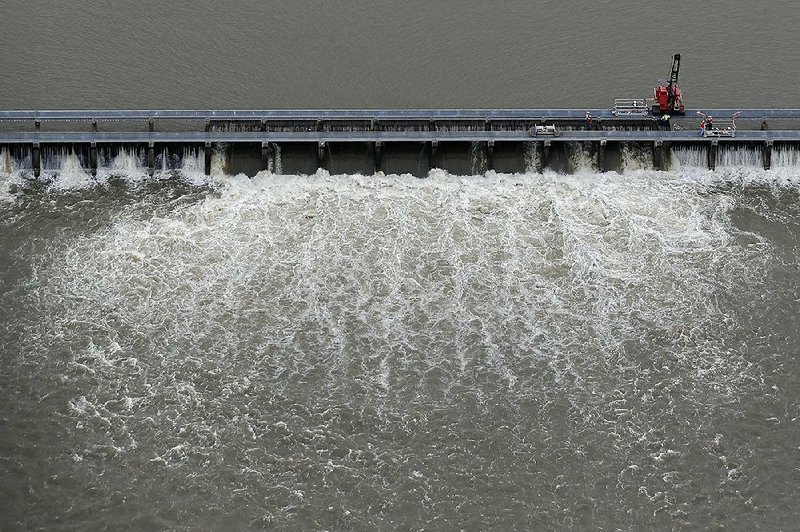NEW ORLEANS -- This is a bad year for people who make their living from seafood in Louisiana and Mississippi. Floods from the Midwest are killing oysters and driving crabs, shrimp and finfish out of bays and marshes, into saltier water where they can survive.
"On a scale of 1 to 10, we are 9-and-a-half destroyed," said Brad Robin, whose family controls about 10,000 acres of oyster leases in Louisiana waters.
"The light at the end of the tunnel right now is about out," he said.
Many species that depend on a brackish mix of fresh and saltwater in coastal estuaries are decamping as this year's floods flush in fresh water, laden with pollution from farms and cities in the Mississippi River basin.
Mississippi Gov. Phil Bryant and Louisiana Gov. John Bel Edwards have asked the federal government for a fisheries disaster declaration to make federal grants, loans and other aid available to affected people. Edwards says the declaration could help commercial fishermen, processors and docks, and aid state rehabilitation of the affected species.
Louisiana's oyster harvest is 80% below average for this time of year and more oysters are expected to die as temperatures rise, according to a preliminary report on the website of the Louisiana Department of Wildlife and Fisheries. Shrimp landings were down 63% and blue crab landings down 45% in April from the five-year average. There's been a drop in the fish catch, but it hasn't reached the statewide average of 35% needed for a federal fisheries disaster declaration, the report says.
"We've been dealing with the river since October," said Acy J. Cooper Jr., president of the Louisiana Shrimp Association "That's a long time it's been high."
The die-offs are as bad in Mississippi. Joe Spraggins, executive director of the Mississippi Department of Marine Resources, said fresh water has killed 80% or more of the state's oysters. He said crabs are down about 40% and brown shrimp landings are down more than 70% from a five-year average.
Marine animals require certain amounts of salt in their water. Oysters can tolerate a wide range of salinity, but a long spell of fresh water coupled with high temperatures can be lethal. Shrimp, crabs and fish simply swim to saltier areas.
Shrimp are now in places only larger boats can reach, said Cooper.
"Some of the big ones are catching a few," he said. "The smaller boats are just catching hell."
In addition, nutrients in river water nourish algae blooms so intense that their decomposition on the sea floor consumes oxygen, creating a dead zone every summer for thousands of square miles off the coast. This year's floods could bring a near-record dead zone, scientists have said.
The Mississippi River watershed drains 41% of the contiguous United States, and the middle of North America has had a wet year.
The prolonged flooding has raised the Mississippi so high for so long that for the first time ever, the Army Corps of Engineers opened a major spillway twice this year, displacing Lake Pontchartrain's usually brackish water and flushing out the Mississippi Sound. The water is also high to the west, where the Atchafalaya River distributes Mississippi River water through Cajun Country swamps.
The floodwaters have killed many of the adult oysters grown at Mississippi's experimental oyster farm on Deer Island, oyster expansion agent Jason Rider said. That island is just off Biloxi, but the spillway's water has reached it via Lake Pontchartrain, about 55 miles west. Rider trained 13 people to grow oysters in raised cages on private farms there. They lost market-sized oysters, but were able to move seed oysters to more hospitable waters in Alabama, said Doug Ankersen of Theodore, Ala., who sold them the fingernail-sized seed oysters.
A disaster declaration would open the way for Congress to appropriate money to help fishermen and businesses that rely on them. For instance, $200 million was provided last June to help fishing communities recover from hurricanes Harvey, Irma and Maria in 2017.
National Oceanic and Atmospheric Administration scientists said Friday that they're investigating whether the floodwaters and lingering effects of the BP Deepwater Horizon oil spill in 2010 contributed to the deaths of at least 279 bottlenose dolphins from Louisiana to the Florida Panhandle, triple the usual number for this time of year.
The high water may last "well through the summer," said Louisiana Wildlife and Fisheries Assistant Secretary Patrick Banks.
"The difficulty is," he said, "when will this even be over?"
Information for this article was contributed by Stacey Plaisance of The Associated Press.
Business on 06/18/2019
